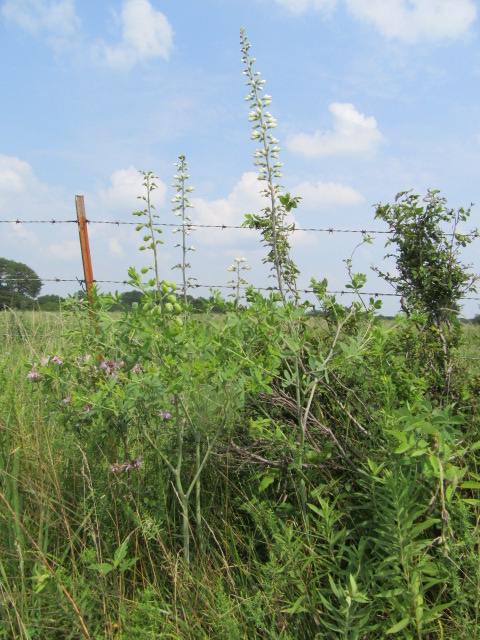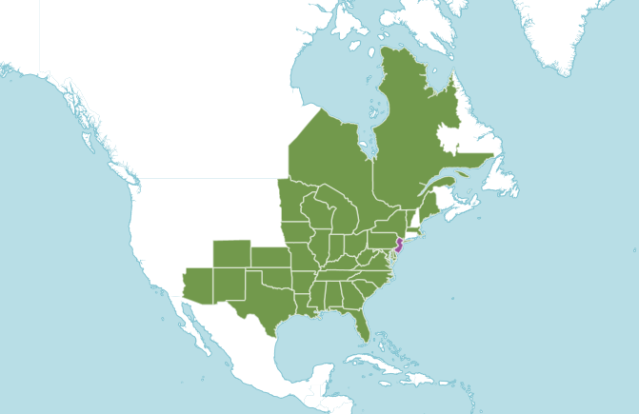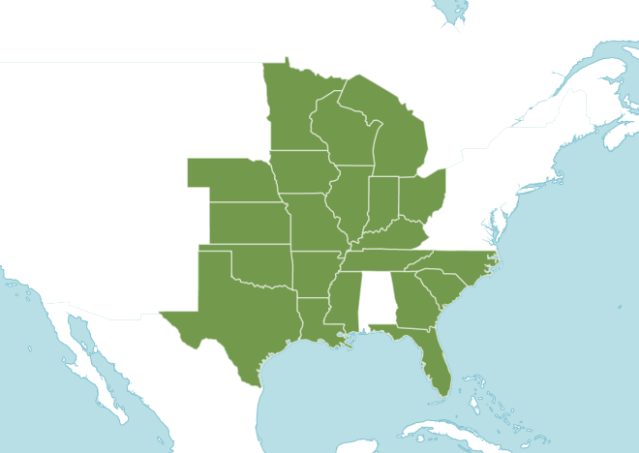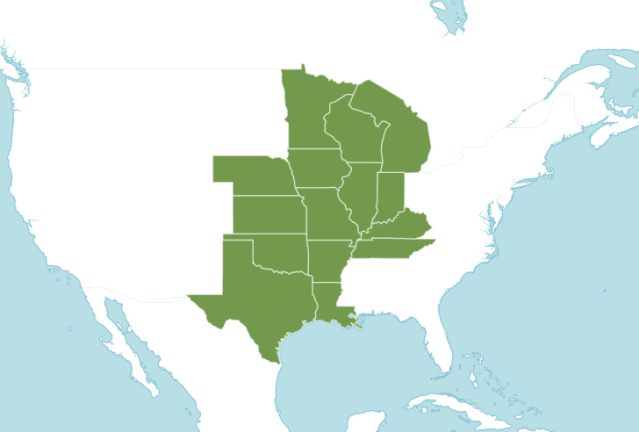
Baptisia lactea (Wild White Indigo, Western White Indigo, ETC.) on 7-22-21, #817-1.
Hello everyone! I hope this post finds you all well. We have had some weird weather in January. If we don’t like something, we can usually change it but weather isn’t one of those things (unless we move). Otherwise, all is well here.
I finished updating The Belmont Rooster 20 days earlier that last year because it went so smoothly. I didn’t have to make a lot of changes as far as species names and synonyms was concerned. But, there was one snag… I remember it well… It was on December 17 when I came to the Baptisia alba var. macrophylla page. The first thing I did was go to Plants of the World Online to make sure the scientific name was the same and the number of synonyms was still correct. Well, there was a HUGE problem. POWO said Baptisia alba var. macrophylla (Larisey) Isely is now a synonym of Baptisia leucophaea Nutt……… Well, I checked out Baptisia leucophaea online, looked at photos, and my first reaction was completely blank. Baptisia leucophaea has pale yellow flowers and the stems are horizontal… Baptisia alba and Baptisia alba var. macrophylla have white flowers on erect racemes (flower stem). How in the heck could a white flowered variety (var, macrophylla) become a synonym of a species of with yellow flowers with horizontal stems?
Well, I sent an email to the editor of POWO like I always do when I have a question. He has always been very helpful, and sometimes I have found a definite error. Sometimes I think I could be a bit of a pest, but he hasn’t complained. You know, I am not a botanist, but anyone could see there was definitely something whacky. His prompt reply was that the name was changed on Flora of North America and apparently they did a study of Baptisia (maybe not in those exact words). That was also puzzling because Flora of North America didn’t have anything online about the plant Fabaceae… SO, I sent an email to my contact from FNA. His prompt reply was they had Fabaceae published but it wasn’t online yet. Fortunately, he sent a PDF of what was to be online eventually. Once I read it, the muddy water cleared somewhat.
But the question still remained… How could a white flowered variety become a synonym of a species with yellow flowers… Since I still had the synonyms of B. alba var. macrophylla, I read the original publications of every one of them. Most were vague and all but two are now synonyms of Baptisia lactea var. lactea. Hmmm… One is a synonym is B. lactea, and one a synonym of Baptisia leucophaea. WAIT A MINUTE! Baptisia lactea?
I had work to do, so I skipped the whole ordeal until I was finished with the rest of the updates. Still the thought of the change kept popping up.
When I was finished I went back to solve they mystery behind the name change. Back to reading the original publications again. To be honest, when some “authors” wrote descriptions in the past, they weren’t quite clear. Some point to another author’s description which was just as bad.
It is quite clear that what most of the websites are and have been calling Baptisia alba var. macrophylla is definitely NOT and never will be Baptisia leucophaea. So, lets have a look at the the ONLY white-flowered Baptisia now found in Missouri, according to FNA’s PDF, which, as I said, isn’t online yet… Baptisia lactea…
Baptisia lactea (Raf.) Thieret was a synonym of Baptisia alba var. macrophylla (Larisey) Isely as named and described as such by Duane Isely in Sida (Contributions to Botany) in 1986. It was previously named and described as Baptisia pendula var. macrophylla by Mary Maxine Larisey in Annals of the Missouri Botanical Garden in 1940. Baptisia pendula var. macrophylla is now “a synonym” of Baptisia leucophaea Nutt... Ahhh… There you see the only former synonym of B. alba var. macrophylla that possibly caused that name to become a synonym of B. leucophaea… Larisey’s original publication of B. pendula says “branches… spreading, declined”…. “corolla white (?)”… If she actually saw the plant, why did she say corolla white (?). Would there be a “?” ? Just thinking…
Now going back a bit further… The former synonym Baptisia lactea (Raf.) Thieret has now been resurrected. It was named as such by John William Thieret in Sida in 1969. It was first named Dolichos lacteus by Constantine Samuel Rafinesquei in Florula Ludoviciana ( A Flora of the State of Louisiana) in 1817.
Let’s go back a little further while I’m on a roll to Dolichos lacteus Raf. from 1817 which is the basionym of Baptisia lactea (Raf.) Thieret… Starting with POWO, going to IPNI (International Plant Names Index) via “other data”, then to the original publication on BHL (Biodiversity Heritage Library) via IPNI… Plants of the World Online allows you to get to the nitty gritty. IPNI doesn’t actually give a link to Dolichos lacteus, but it is on page 103 of Florula Ludoviciana (a Flora of the State of Louisiana). When you open the publication, just scroll down down and click on any species name, click on BHL, then scroll down to page 103. There you will find:
Caule erecto terei glabro, apice ramoso, ramis horizontalis; foliolis oblongis, mollibus: racemis elongatis, leguminibus caliculatis oblongis turgidus. Raf.—Josephine, Rob. p. 502, and 267. Fine perennial plant, sending every year a shoot similar to that of asparagus and glaucous; the folioles are ternated and stipulated, the flower of a milk white, seeds yellow and small; grows in meadows. It is said that it possesses the property of mitigating acute pain, and purifying the blood; the seeds may be eaten.
Latin Translated from Google:
The erect stem is glabrous, with a branched tip, and horizontal branches; oblong, soft leaves: elongated clusters, turgid with oblong caliculate vegetables
[OK, I wouldn’t eat the seeds or recommend using it for pain or to purify the blood unless you get a supplement from a reliable supplier AND get the advice of a doctor.]
That is be beginning of Baptisia lactea. You can do basically the same thing to find information on any species and synonyms… You can do the same thing through Tropicos and World Flora Online as long as there is a link to IPNI or BHL.
Basically, what I am getting at here is that even though Baptisia alba var. macrophylla is now a synonym of Baptisia leucophylla, B. leucophaea is NOT the species represented on the vast majority of websites talking about Baptisia alba. var. macrophylla. That would most likely now be Baptisia lactea.
Let me show you some current maps published on Plants of the World Online:
The genus Baptisia…

Distribution map for the Baptisia genus from the USDA Plants Database. Published on the internet at https://plants.sc.egov.usda.gov/home. Retrieved on January 22, 2024.
As of 1-22-24, Plants of the World Online lists 18 accepted species in the genus Baptisia. It is a member of the plant Fabaceae. No map is perfect, but this is from data provided to POWO from Flora of North America.
Baptisia alba (L.) R.Br.

Distribution map for Baptisia alba from the USDA Plants Database. Published on the internet at https://plants.sc.egov.usda.gov/home. Retrieved on January 22, 2024.
The above map for Baptisia alba from Plants of the World Online shows the range for only seven states in the U.S. Alabama, Florida, Georgia, North Carolina, South Carolina, Tennessee, and Virginia. There are no infraspecific names listed…
Baptisia lactea (Raf.) Thieret:

Distribution map for Baptisia lactea from the USDA Plants Database. Published on the internet at https://plants.sc.egov.usda.gov/home. Retrieved on January 22, 2024.
The above distribution map for Baptisia lactea (Raf.) Thieret is from Plants of the World Online. As I mentioned above, this scientific name was a synonym of Baptisia alba var. macrophylla. This map is very close to the former map for Baptisia alba… There are two lower taxon for B. lactea… B. lactea var. lactea (autonym) and B. lactea var. pendula (Larisey) B.L.Turner. When an infraspecific taxon is named, an autonym is automatically created that is closest to the original species… In this case, Baptisia lactea var. pendula is found in Florida, Georgia, North Carolina, and South Carolina. If you remove those states from the above map, you will have the range for Baptisia lactea var. lactea… B. lactea var. pendula has a similar range as B. alba… So, for Missouri where I live, and the species have observed and photographed and have a page for, is NOW Baptisia lactea where it used to be…. Well, you get the idea…
Now for Baptisia leucophaea Nutt….

Distribution map for Baptisia leucophaea from the USDA Plants Database. Published on the internet at https://plants.sc.egov.usda.gov/home. Retrieved on January 23, 2024.
The above distribution map for the resurrected Baptisia leucophaea Nutt. is from Plants of the World Online. Baptisia leucophaea was named and described by Thomas Nuttall in 1818. It became a synonym of Baptisia bracteata var. leucophaea (Nutt.) Kartesz & Gandhi as suggested by John T. Kartesz and Kanchi Natarajan Gandhi in 1991. Well, it now once again Baptisia leucophaea. HOLY CRAP! The above map is almost the same range as Baptisia lactea var. lactea minus a couple of states… Baptisia leucophaea has no lower taxon listed.
I am honestly looking forward to seeing a Baptisia leucophaea in person… According to iNaturalist, there have been observations of B. bracteata and B. bracteata var. leucophaea not far from here. OOPS!!! The range has now changed drastically… Oh, I’m sorry… I almost forgot B. bracteata var. leucophaea is now B. leucophaea. The current native range for B. bracteata is Alabama, Georgia, North Carolina, South Carolina. It has been introduced to Massachusetts and New Jersey.
Time for another flag for iNaturalist. When you flag a species for a taxon change (name change) on iNaturalist, it may take a while for it to be approved. Been there done that, but it is understandable. Especially when you consider the list of flags is growing daily and not for just plants. They deal with pretty much everything living except for humans… I was getting ready to flag a species in January but someone beat me to it… Four years earlier and it is just now in the draft stage. I am certainly not knocking iNaturalist. It is a great site and I post all my observations there. The maps are continually updated as members post observations.
I apologize, I got off track… Now, where was I? Oh yeah, maps. Just remember, the maps may not be 100% accurate, but I think Flora of North America is pretty close. Some people prefer using the maps on BONAP (the Biota Project of North America) or the USDA Plants Database. They should be close since the USDA’s data came from BONAP. Even so, they aren’t always the same. Maps are just a guide and species distribution can change easily because they spread, haven’t been observed even though present, or environmental factors.
I realize most of my blog readers aren’t interested, but it will be published online and maybe others will find this post useful. Likely, the scientific names won’t change on many GREAT websites because once they publish information they never make updates for whatever reason they may have. Maybe they are short staffed or perhaps a one man operation. That’s OK in most cases, as long as the name they use is validly published and a synonym of a species that will point them in the right direction. This is not one of those times as the name change leads in at least two directions… White flowers and/or yellow flowers… Once Flora of North America’s Fabaceae is up and running online, you will be able to see all of the Baptisia species in North America, see the maps, and read descriptions.
By all means, if you see I have made an error, please let me know with a comment or through “contact” at the top of the page.
You can read my page for Baptisia lactea and view all the photos I have taken by clicking HERE. I purposely haven’t changed the URL from Baptisia alba var. macrophylla…
I’m finished blabbing now although I get the feeling I left something out…
Until next time, take care, stay positive, and always be thankful. Thanks for visiting!